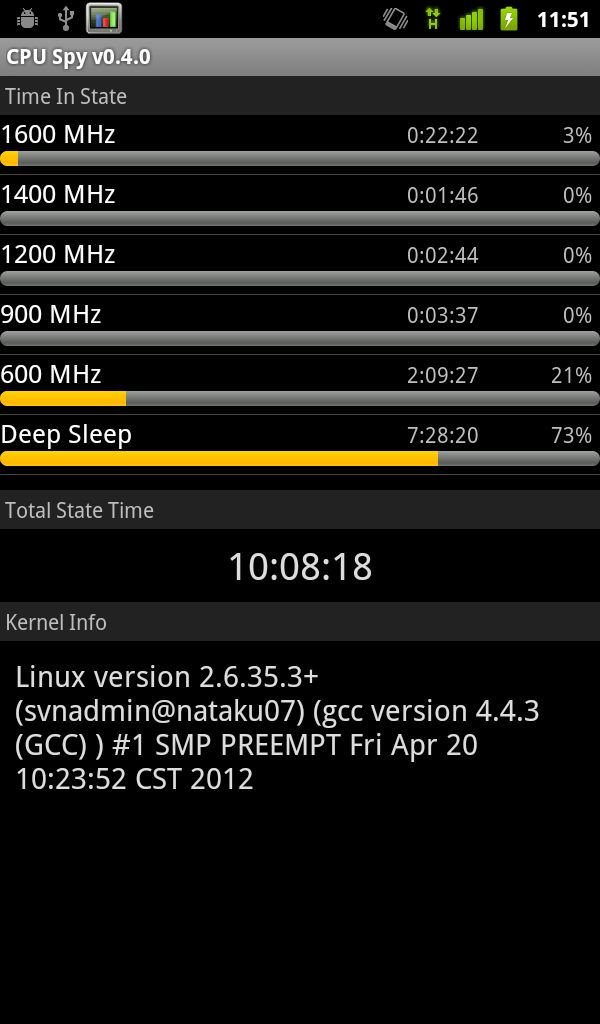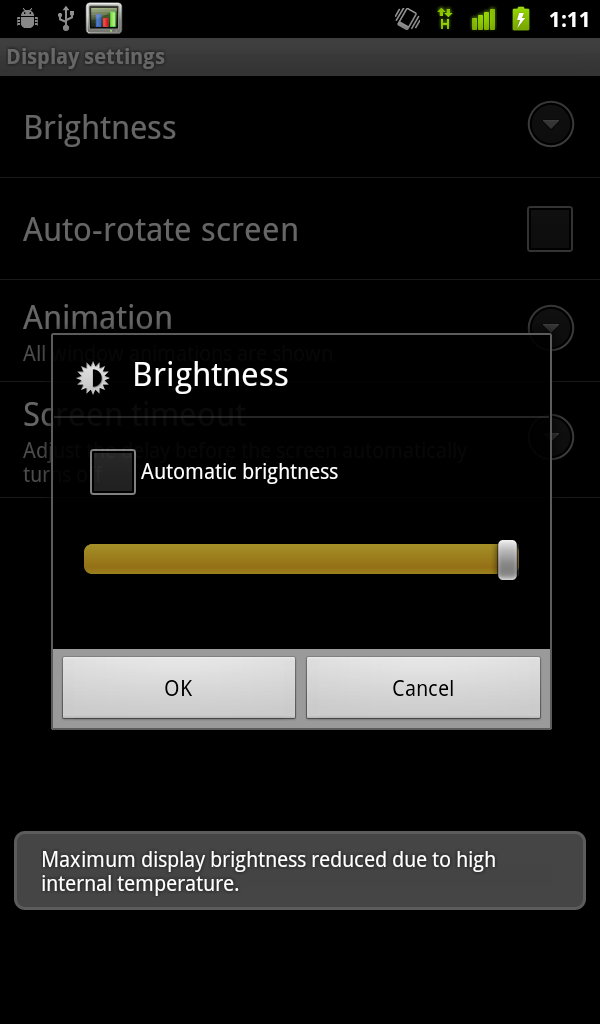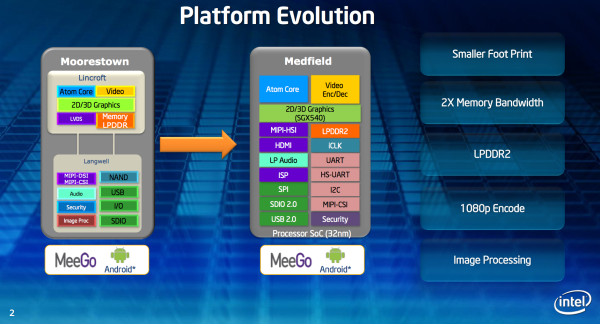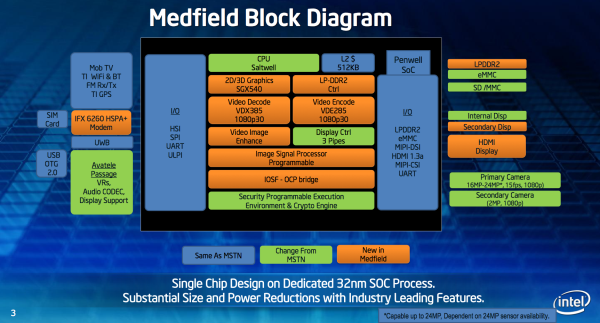Lava Xolo X900 Review - The First Intel Medfield Phone
by Brian Klug on April 25, 2012 6:00 AM ESTMedfield: Intel in a Smartphone
I touched on this before but there were a number of reasons we never saw Moorestown in a smartphone. One part of the problem was the number of packages required to implement the platform, the other was that it simply lacked some of the things that smartphone OEMs implicitly expect to live on an SoC. The internal Intel guidance was that Moorestown required 2 packages to implement (Lincroft and Langwell), and in addition to those two you needed an external PMIC and DRAM. There wasn’t support for PoP memory, only external LPDDR1, and there was only support for 5 MP camera and 720p encode.
Medfield builds in every way on top of this by delivering a bona fide SoC with PoP LPDDR2 (2 x 32 bit support), improved ISP from Intel’s Silicon Hive acquisition, video encode and decode blocks from Imagination, SGX 540 graphics at 400 MHz, additional I/O, and an external Avatele Passage PMIC (Intel calls this an MSIC). The result is a platform that looks to an OEM like any of the other competitors - it’s a combination of SoC, PMIC, and some PoP LPDDR2, as opposed to the previous solution which required two additional external packages. Intel has a few slides online about this evolution and how things have moved inside the single Medfield package, and the result again is something that finally looks like any one of countless ARM-based SoCs.
The specific part inside the X900 is an Atom Z2460 32nm SoC (the platform is Medfield, Penwell is the SoC, and the CPU inside is a Saltwell), and inside a Penwell is the Atom Saltwell core running at up to 1.6 GHz with 512KB of L2 cache, a PowerVR SGX 540 GPU at 400 MHz, and a dual channel LPDDR2 memory interface. Anand has already written about the CPU architecture itself pretty comprehensively, and how it compares to ARM’s Cortex A9 and A15 designs. The long and short of it is that Saltwell is still a dual-issue, in-order core with Hyper-Threading support. There’s a 16 stage integer pipeline, no dedicated integer multiply or divide units (they’re shared with the floating point hardware), and in addition to the 512KB L2 cache there’s a separate 256KB SRAM which is lower power and on its own voltage plane. When Saltwell goes into its deepest sleep state, the CPU state and some L2 cache data gets parked here, allowing the CPU voltage to be lowered even more than the SRAM voltage. As expected, with Hyper-Threading the OS sees two logical cores to execute tasks on.
The other interesting thing is support for EIST and additional C states when the device is idle. Dynamic CPU clocks through the linux governor is something absolutely critical for getting a smartphone with acceptable battery life. What’s interesting here is that Penwell’s advertised dynamic range is between 100 MHz and 1.6 GHz with fine grained 100 MHz increments between, in addition to the C6 state where CPU state data is saved in the on-SoC low power SRAM and the platform is basically suspended (deep sleep).
However, the Android governor onboard the X900 only includes a few steps between 600 MHz and the maximum 1.6 GHz burst clock, in addition to C6. You can see this either by inspecting the governor’s available scaling frequencies:
$ cat /sys/devices/system/cpu/cpu0/cpufreq/scaling_available_frequencies 1600000 1400000 1200000 900000 600000 $ cat time_in_state 1600000 233495 1400000 12304 1200000 19780 900000 25801 600000 5306262
Or by using an Android application which inspects exactly this data. I spent a day with the Medfield phone in my pocket and made a note of capturing what the state data was after the day’s end, and the CPU does indeed go into C6 while idle and in the pocket, and spend a lot of time at the minimum 600 MHz clock with some bursts to 1.6 GHz when I’m doing things.


The reality is that most of the smartphone’s time is really spent idling, waking up only to watch some DRX slots or process background tasks. It is curious to me however that Intel isn’t implementing their Ultra-LFM modes between 100 and 600 MHz - it’s possible there’s no voltage scaling below 600 MHz which in turn doesn’t make it worth jumping into these lower clocks quite yet.
Depending on the device’s thermals, Intel’s governor will select between those available frequencies. There actually are four thermal zones in the device, on the back, front, baseband, and SoC itself. The SoC can go up to 90C before you get throttled (which is pretty typical for Intel CPUs), 75 C on the back, 64 C on the front, and 80 C on the modem. Those sound high but aren’t out of the ordinary for some of the other SoCs I’ve seen who have similar thermal management. In addition, if the platform gets too hot, the display brightness will be clamped to 50%.
I have to admit that I did see the display brightness get clamped once as shown above, but only once during a period where I was running the display at 100% brightness and maxing out the CPU. The bottom back of the X900 can indeed get warm, but nothing inordinate or near the thermals that are set in the software management.
Finally, Saltwell supports the same instruction set as Core 2, including SSE3 and Intel 64. We can check this by looking at the CPU flags from cpu_info as well:
processor : 0vendor_id : GenuineIntelcpu family : 6model : 39model name : Intel(R) Atom(TM) CPU Z2460 @ 1.60GHzstepping : 2cpu MHz : 600.000cache size : 512 KBphysical id : 0siblings : 2core id : 0cpu cores : 1apicid : 0initial apicid : 0fdiv_bug : nohlt_bug : nof00f_bug : nocoma_bug : nofpu : yesfpu_exception : yescpuid level : 10wp : yesflags : fpu vme de pse tsc msr pae mce cx8 apic sep mtrr pge mca cmov pat clflush dts acpi mmx fxsr sse sse2 ss ht tm pbe nx constant_tsc arch_perfmon pebs bts nonstop_tsc aperfmperf pni dtes64 monitor ds_cpl vmx est tm2 ssse3 xtpr pdcm movbe lahf_lm arat tpr_shadow vnmi flexprioritybogomips : 3194.88clflush size : 64cache_alignment : 64address sizes : 32 bits physical, 32 bits virtualpower management:
The rest of the Medfield platform we’ll talk about in the appropriate sections, but the big takeaway is that Intel finally has a real x86 SoC for smartphones and tablets. In addition to the Z2460 that we’re looking at in the X900, Intel has two other SKUs which round out the high end and low end. At the low end is the Z2000 which is functionally identical to the Z2460 but with a maximum CPU clock of 1.0 GHz, no HT, and an SGX 540 clock of 320 MHz, and the Z2580 which is clearly targeted at Windows 8 tablets with two Saltwell cores clocked up to 1.8 GHz, and PowerVR SGX544MP2 graphics at 533 MHz for Direct3D 9_3 compliance.












106 Comments
View All Comments
iwod - Wednesday, April 25, 2012 - link
Since Phone Maker can just buy a reference design from ARM, and all other parts, then Fab them with TSMC, the only cost is a Engineering Team and Fab Cost. For Phone Maker with Large Volume, The Total cost of SoC is much cheaper then say buying from Nvidia.SoC Margin is much smaller then what they used to get with Desktop and Laptop Chip. So unless Intel's smartphone SoC is MUCH faster, otherwise there just aren't any incentive of changing over.
ExarKun333 - Wednesday, April 25, 2012 - link
I doubt you know the exact pricing of all the options. If NV and Intel were not competitive competitive price-wise, they wouldn't be in the market...fm123 - Thursday, April 26, 2012 - link
Not necessarily true. Since Intel could be using it as a loss leader to take marketshare even at 0 profit. The desktop non-SoC Atom pricing starts around $40 (based on their pricelist), while something like Tegra2 is in the below $20 and Tegra3 supposedly in the $20's.Intel can throw lots of money at this and not make any for quite a while. Since part of the plan was likely to create a reference design anyone could sell, that is apparently what they are doing.
UltraTech79 - Thursday, April 26, 2012 - link
None of what you said made "If NV and Intel were not competitive competitive price-wise, they wouldn't be in the market..." an untrue statement.fm123 - Friday, April 27, 2012 - link
If Intel "sells" for little to no profit, then it could be price competitive for the people buying it. Nvidia has to make some profit, because they are far smaller with less bank account than Intel. Intel's own current pricing of Atom shows they are way out there based on their current operating margins, but again that's not their initial goal anyway.Given that Intel had to spend lots to develop the reference design and port Android, they clearly invested massive R&D into the project. They have offered this service to anyone wanting to sell the phone without extra cost, you can't take an Nvidia reference and sell it as they don't do final designs and software. So they don't care about the time schedule as long as they can get marketshare, but they offer a fully manufacturable product, just like GPU reference design boards AMD and Nvidia offer.
This was the argument I always brought up, Intel has a specific margin range they sell at. Mobile products are lower margin than they would prefer, but they need to take away market share from competition, it's similar to getting greater margins.
kuroxp - Monday, May 21, 2012 - link
After that big EU fine, I'd be surprised if Intel sold their stuff below cost....Lucian Armasu - Friday, April 27, 2012 - link
Could they be doing price dumping? Either way, check this out:"Intel's Oak Trail platform, paired Atom Z670 CPU (US$75) with SM35 chipsets (US$20) for tablet PC machine, is priced at US$95, already accounting for about 40% of the total cost of a tablet PC, even with a 70-80% discount, the platform is still far less attractive than Nvidia's Tegra 2 at around US$20."
http://www.digitimes.com/news/a20110815PD216.html
The CPU from Xolo is from the same Z class, so it should cost about the same, especially with it being newer and all.
B3an - Wednesday, April 25, 2012 - link
It's too thick, average performance, average battery and dont compare to Krait / A15 ARM SoC's which was really needed being as A9 is old news. But atleast it's a reasonable attempt this time. Unlike all other failed Intel attempts in this area. So quite good-ish news for Win 8 tablets...I just hope the dual core version for Win 8 tablets is clocked considerably higher because i'll be get a Win 8 tablet but the question is which one, and i'd like it to have good performance compared to ARM based alternatives because i'd like to run x86 software, but if the WinRT ARM alternatives are better by a large margin it might be enough to make me forget about x86.
Latzara - Wednesday, April 25, 2012 - link
Too thick - it's thicker than the ones it's compared with here - but calling 1.1 cm 'Too thick' compared to 0.95 or similar is preposterous cause it basically feels the same in your hand and usage wise it's no differentB3an - Wednesday, April 25, 2012 - link
Thats purely your opinion and i'm sure you're a minority. Many people are not even going to consider this because of it's thickness.When compared to nearly all other phones of similar performance/spec that have come out in 2012 this phone is likely thicker than atleast 98% of them. Even most phones from 2011 were often thinner. And it might be slight difference but it's easy to feel and see.